Ho Chi Minh Mausoleum (or Uncle Ho’s mausoleum) is one of the famous works not only having cultural and historical value but also attracting a lot of tourists to visit and pay their respects to the old father of the people. Vietnamese ethnicity. Now, with VNTRIP.VN, refer to the following detailed and complete guide and experience to visit Uncle Ho’s mausoleum!
1. Introduction to Uncle Ho’s mausoleum
Uncle Ho’s mausoleum is one of the most prominent places that tourists cannot ignore when traveling to Hanoi. The mausoleum was officially started on September 2, 1973 and completed on August 19, 1975. This is the place to keep the body of President Ho Chi Minh, an outstanding leader of the nation, a world cultural celebrity. Uncle Ho’s mausoleum is located in the mausoleum complex including Ba Dinh Square, Presidential Palace, Uncle Ho’s stilt house…
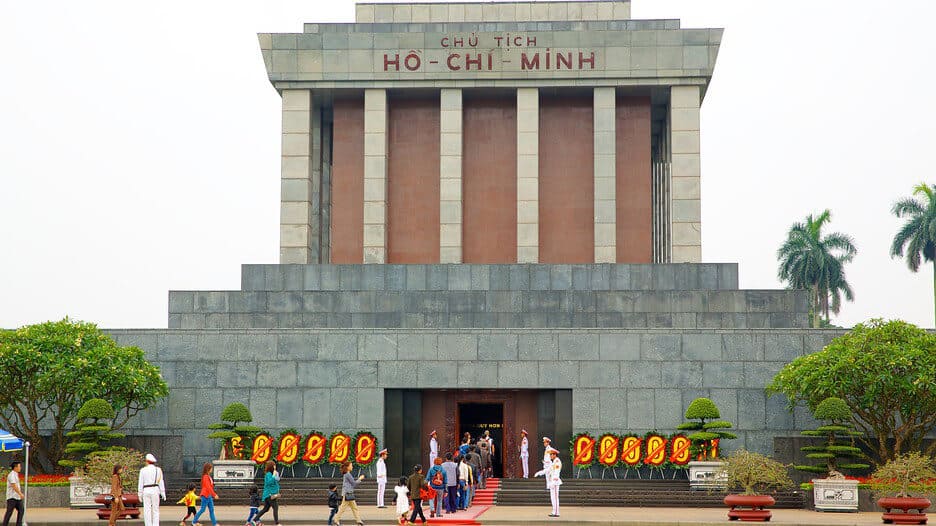
Ho Chi Minh Mausoleum (photo collection)
The main face of the mausoleum facing the east is Ba Dinh Square. The mausoleum consists of 3 layers with a height of 21.6m. The lower class has a multi-level structure, with a platform for the presidium when the meeting takes place. The middle part is the central structure of the mausoleum including the body room, corridor, stairs up and down. The upper part is the roof of the mausoleum stylized in the shape of a blooming lotus. In front of the main mausoleum, there is the inscription of President Ho Chi Minh in plum-colored ruby.
2. Calendar and opening hours of Uncle Ho’s mausoleum
- In the summer, from April to the end of October, the mausoleum is open from 7:30 am to 10:30 pm. On Saturday, Sunday and other public holidays, the mausoleum is open from 7:30 a.m. to 11 a.m.
- In winter, from November to the end of March next year, the mausoleum is open from 8am to 11am. For Saturdays, Sundays and public holidays, the mausoleum is open from 8:30 a.m. to 11:30 a.m.
Uncle Ho’s mausoleum is usually open on weekday mornings except Monday and Friday. However, on special days such as the 1st of the Lunar New Year, May 19 (Uncle’s birthday) and September 2 (National Day) that fall on a Monday or Friday, the mausoleum will still be open.
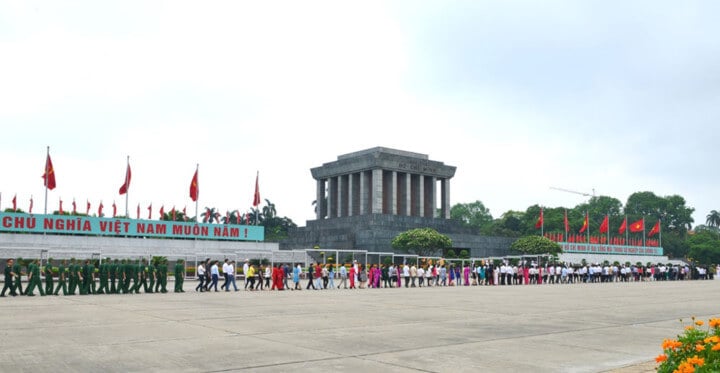
The flow of people visiting Uncle Ho’s Mausoleum (collected photos)
3. Ticket price to enter Uncle Ho’s mausoleum
– The entrance ticket to the Presidential Mausoleum with foreign tourists is 25,000 VND / time, and 25,000 VND tickets to visit Uncle Ho’s stilt house, where Uncle Ho used to live.
– For Vietnamese, there is no entrance ticket.
4. Means to Uncle Ho’s mausoleum
If you visit Uncle Ho’s mausoleum by motorbike, you can park your car outside at Ong Ich Khiem Street – opposite the Mausoleum Command post or 19 Ngoc Ha Street – the entrance to the Ho Chi Minh Museum. By bus, you can take routes 09, 18, 22, 33, 45, 50 to the stop at 18A Le Hong Phong, which is the closest point to Uncle Ho’s mausoleum.
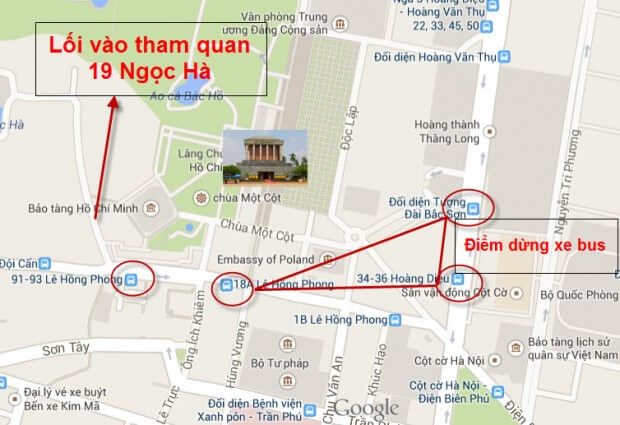
Entrance to visit Uncle Ho’s mausoleum (collected photos)
5. Notes and dress rules when visiting Uncle Ho’s mausoleum
Clothing when visiting Uncle Ho’s mausoleum: Dress neatly and politely, not wearing skirts that are too short or revealing, offensive in nature.
– Attitude: Be gentle, walk softly, speak quietly without causing noise or disorder, line up in order when entering the mausoleum. When entering the mausoleum, you should remove your hat and do not put your hands in your pockets.
You can bring phones and cameras, but you are not allowed to take pictures or record videos in prohibited areas, especially inside the mausoleum.
– Children from 3 years old and above are only allowed to enter the mausoleum.
6. Journey to visit Uncle Ho’s mausoleum.
Normally, visitors will be able to visit the entire area in the sequence: Uncle Ho’s Mausoleum to Uncle Ho’s house on stilts, Uncle Ho’s fish pond, then visit Ho Chi Minh museum and finally One Pillar Pagoda.
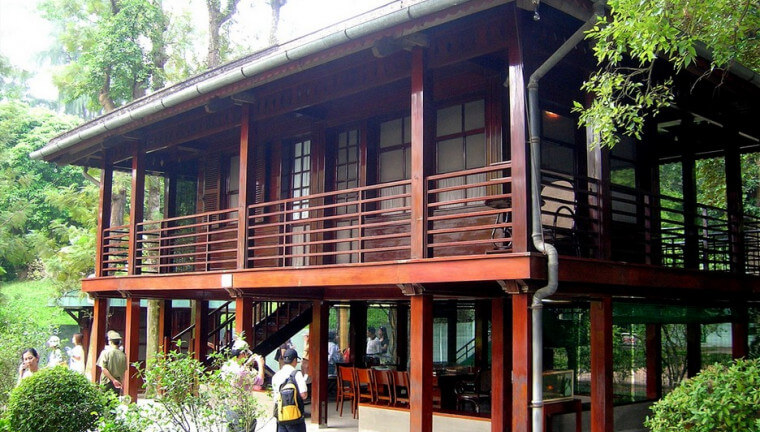
Uncle Ho’s stilt house (photo collection)
From the entrance to Ho Chi Minh Museum at 19 Ngoc Ha, Ba Dinh, you follow the instructions of the mausoleum management board or follow the flow of people to visit Uncle Ho’s mausoleum. On summer days, or holidays, the line will be quite long and crowded, so remember to queue. When entering the mausoleum, follow the instructions of the signposts and follow the line of people ahead.
The road from the mausoleum to Uncle Ho’s house on stilts is very beautiful, with a lake and garden, so the atmosphere is extremely cool. Visitors can learn more about Uncle Ho’s life and revolutionary career or visit a small, simple house to know more about his simple life. After visiting the stilt house, the Presidential Palace and the museum will go to the refreshment counter and sell souvenirs.

One Pillar Pagoda (photo collection)
Finally, you can visit One Pillar Pagoda – an extremely unique architectural work of our country with an established record: The temple has the most unique architecture. One Pillar Pagoda is known as the thousand-year-old lotus of Hanoi capital, is one of the symbols of the capital, so if you come here, remember to stop by this temple to see firsthand the beauty of Hanoi. it okay.
7. Flag raising ceremony – flag lowering ceremony at Uncle Ho’s Mausoleum
A special thing right in front of Uncle Ho’s mausoleum is that every morning and evening there are flag raising and flag lowering ceremonies in Ba Dinh square.
The flag raising ceremony is a national ceremony, performed at 6 a.m. every day in front of President Ho Chi Minh’s mausoleum in Hanoi. The flag raising delegation departed from behind the mausoleum of President Ho Chi Minh, led by the military flag of Quyet Victory. After that, there was a team of 34 people to destroy the army, representing the first 34 soldiers of the Vietnamese team to propagate the liberation of the army. The group went around to the front to the music of the song “Step under the military flag” to reach the foot of the flagpole.
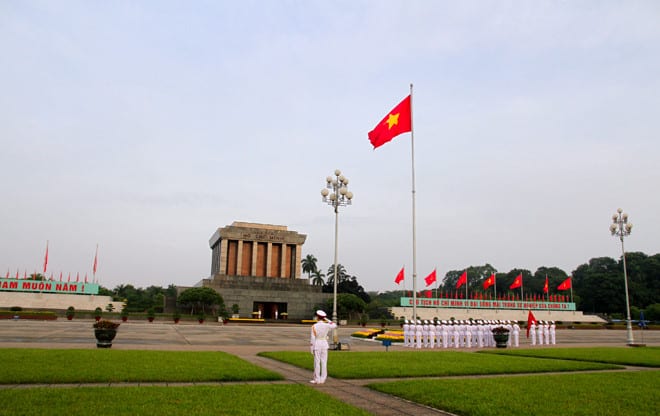
Flag raising ceremony at Uncle Ho’s Mausoleum (collected photos)
Three soldiers of the red flag team will go to the flagpole to prepare for the flag raising ceremony, at this time the door of the President’s mausoleum begins to open. At the signal, the flag is launched and raised to the tune of the national anthem, the flag is hoisted to the top of the flagpole. After the flag raising ceremony, the army squad walked around in front of Uncle Ho’s mausoleum and ended the ceremony.
The flag-lowering ceremony takes place at 9pm every day, with the same ritual as the flag-raising ceremony. The flag-raising ceremony is performed by soldiers in the most solemn and sacred way to keep the image of the country’s flag.
Source: Collected internet.